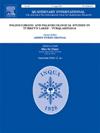Heat, hydroclimate and herbivory: A late-pleistocene record of environmental change from tropical western Africa
IF 1.9
3区 地球科学
Q3 GEOGRAPHY, PHYSICAL
引用次数: 0
Abstract
Fire shapes ecological dynamics across many regions of Africa today and plays a critical role in the maintenance of grass dominated (savannah) ecosystems in regions which could climatically support forest vegetation, such as the Dahomey Gap in western Africa. However, the importance of fire relative to other important factors (such as herbivory and moisture availability) remains relatively poorly quantified. Here we present new macrocharcoal data (particles >160 μm) from Lake Bosumtwi (Ghana) spanning the last c. 50 thousand years (ka). The macrocharcoal data are interpreted to provide evidence of high biomass consuming fires within the lake catchment (c. 52 km2). The macrocharcoal data are compared with previously published evidence of regional fires (microcharcoal), vegetation (pollen), herbivory (spores of coprophilous fungi), and moisture availability (δ 15N). The macrocharcoal data suggest three phases of increased fire severity (biomass consumption) during the last c. 50 ka: (i) 50–44 ka, (ii) 37–30 ka, and (iii) 26–10 ka. Covariance between high concentrations of macrocharcoal and grass pollen during these periods suggests that grass was likely providing most of the fuel load for the fires. After c. 10 ka macrocharcoal disappears from the sediments, suggesting high severity fires disappeared from the local landscape after this time. This decline in fire follows a decrease in herbivory within the landscape and occurs against a backdrop of increasing precipitation. We suggest that this combination of factors resulted in the loss of fire and contributed to the rise of a vegetation formation around Lake Bosumtwi during the Holocene that was unlike any seen in the last c. 500 ka.
热、水文气候和草食:西非热带地区环境变化的晚更新世记录
今天,火塑造了非洲许多地区的生态动态,并在维持以草为主的(稀树草原)生态系统方面发挥着关键作用,这些地区可能在气候上支持森林植被,如西非的达荷美峡谷。然而,相对于其他重要因素(如草食和水分有效性),火的重要性仍然相对缺乏量化。在这里,我们提出了来自加纳Bosumtwi湖的新的宏观碳数据(颗粒>;160 μm),跨越了近5万年(ka)。对大炭数据进行了解释,以提供湖泊集水区(约52平方公里)生物质消耗量大的火灾的证据。将大炭数据与先前发表的区域火灾(微炭)、植被(花粉)、草食(嗜腐真菌孢子)和水分有效性(δ 15N)的证据进行比较。宏观木炭数据表明,在最后一个c. 50 ka期间,火灾严重程度(生物量消耗)增加有三个阶段:(i) 50 - 44 ka, (ii) 37-30 ka和(iii) 26-10 ka。在这些时期,高浓度的大炭和草花粉之间的协方差表明,草可能为火灾提供了大部分的燃料负荷。大约10 ka后,沉积物中的大炭消失,表明在此之后,当地景观中消失了严重的火灾。火灾的减少是在景观内食草动物减少和降水增加的背景下发生的。我们认为,这些因素的组合导致了火灾的减少,并促成了全新世期间Bosumtwi湖周围植被形成的增加,这与最近的c. 500 ka不同。
本文章由计算机程序翻译,如有差异,请以英文原文为准。
求助全文
约1分钟内获得全文
求助全文
来源期刊

Quaternary International
地学-地球科学综合
CiteScore
5.60
自引率
4.50%
发文量
336
审稿时长
3 months
期刊介绍:
Quaternary International is the official journal of the International Union for Quaternary Research. The objectives are to publish a high quality scientific journal under the auspices of the premier Quaternary association that reflects the interdisciplinary nature of INQUA and records recent advances in Quaternary science that appeal to a wide audience.
This series will encompass all the full spectrum of the physical and natural sciences that are commonly employed in solving Quaternary problems. The policy is to publish peer refereed collected research papers from symposia, workshops and meetings sponsored by INQUA. In addition, other organizations may request publication of their collected works pertaining to the Quaternary.
 求助内容:
求助内容: 应助结果提醒方式:
应助结果提醒方式:


